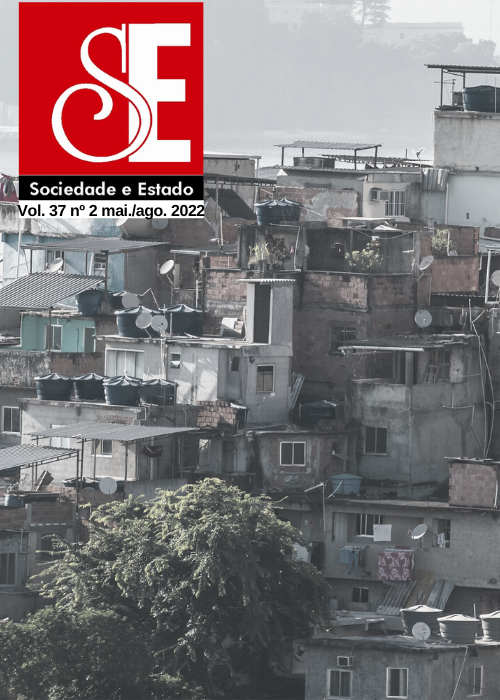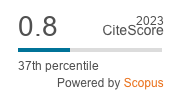Escala do índice de exposição da criança à privação material em Portugal: validação e interpretação
DOI:
https://doi.org/10.1590/s0102-6992-202237020003Palavras-chave:
privação material, pobreza infantil, modelos de resposta ao item, índice social, PortugalResumo
Neste artigo pretende-se contribuir para a validação e interpretação da escala do índice de exposição da criança à privação material no domicílio com base na amostra portuguesa do EU-Statistics on Income and Living Conditions (EU-SILC) de 2017. O índice foi desenvolvido a partir de itens do questionário dos domicílios por meio da aplicação de um modelo da teoria da resposta ao item. Para a sua validação, realizou-se análise descritiva da escala segundo variáveis sociais do EU-SILC. A interpretação se deu pela descrição das categorias dos itens segundo perfis de domicílios agrupados em clusters. Os resultados mostram que 14,3% dos agregados familiares com crianças podem ser classificados como em situação de privação extrema e 25,6% num nível intermédio de privação. Tendo em conta que o EU-SILC é aplicado em todos os países da União Europeia, a metodologia pode ser extensível a esses países permitindo o monitoramento anual da pobreza infantil.
Downloads
Referências
AJZENSTADT, Mimi; GAL, John. Children, gender and families in Mediterranean welfare states. Dordrecht, NL: Springer Netherlands, 2010. Disponível em: <https://doi.org/10.1007/978-90-481-8842-0>. Acesso em : 10 Jun. 2021.
» https://doi.org/10.1007/978-90-481-8842-0
ALKIRE, Sabina; FOSTER, James. Counting and multidimensional poverty measurement. Journal of Public Economics, v. 95, n. 7-8, p. 476-487, 2011. Disponível em: <https://doi.org/10.1016/j.jpubeco.2010.11.006>. Acesso em: 24 Nov. 2020.
» https://doi.org/10.1016/j.jpubeco.2010.11.006
BARTHOLOMEW, David J. et al. The analysis and interpretation of multivariate data for social scientists. Boca Raton, FL; London; New York; Washignton, DC: Chapman & Hall/CRC, 2002.
BASTOS, Amélia. A review of child poverty approaches: the European Union experience. In: PETMESIDOU, Maria et al. (Eds.). Child poverty, youth (un)employment, and social inclusion, p. 41-67. Stuttgard, DE: Ibidem-Verlag, 2016. Disponível em: <https://bora.uib.no/bora-xmlui/handle/1956/17213>. Acesso em: 10 Fev. 2022.
» https://bora.uib.no/bora-xmlui/handle/1956/17213
BASTOS, Amélia; MACHADO, Carla. Children and the dynamics of poverty and social exclusion: empirical evidence for Portugal. International Journal of Social Economics, v. 45, n. 9, p. 1385-1404, 2018. Disponível em: <https://doi.org/10.1108/IJSE-01-2016-0035>. Acesso em: 02 Fev. 2021.
» https://doi.org/10.1108/IJSE-01-2016-0035
BEN-ARIEH, Asher. Beyond welfare: measuring and monitoring the state of children - new trends and domains. Social Indicators Research, v. 52, n. 3, p. 235-257, 2000. Disponível em: < http://dx.doi.org/10.1023/A:1007009414348>. Acesso em: 25 Jun. 2021.
» http://dx.doi.org/10.1023/A:1007009414348
BENEDETTI, Ilaria; BETTI, Gianni; CRESCENZI, Federico. Measuring child poverty and its uncerteinity: a case study of 33 European countries. Sustainability, v. 12, n. 19, 2020. Disponível em: <https://doi.org/10.3390/su12198204>. Acesso em: 30 Jun. 2021.
» https://doi.org/10.3390/su12198204
BORTOLOTTI, Silvana Ligia V. et al. Relevance and advantages of using the item response theory. Quality & Quantity, v. 47, n. 4, p. 2341-2360, 2012. Disponível em: <https://doi.org/10.1007/s11135-012-9684-5>. Acesso: 15 Jun. 2021.
» https://doi.org/10.1007/s11135-012-9684-5
BRADSHAW, Jonathan; RICHARDSON, Dominic; RITAKALLIO, Velli-Matti. Child poverty and child well-being in Europe. Journal of Children’s Services, v. 2, n. 1, p. 18-36, 2007. Disponível em: <https://doi.org/10.1108/17466660200700003>. Acesso em: 16 Jun. 2021.
» https://doi.org/10.1108/17466660200700003
CHALMERS, Phil. Mirt: A multidimensional item response theory package for the R environment. Journal of Statistical Software, v. 48, n. 6, p. 1-29, 2012. Disponível em: <https://doi.org/10.18637/jss.v048.i06 >. Acesso: 01 Fev. 2021.
» https://doi.org/10.18637/jss.v048.i06
CLAIR, Amy. Housing: an under-explored influence on children’s wellbeing and becoming. Child Indicators Research, v. 12, n. 2, p. 609-626, 2019. Disponível em: <https://doi.org/10.1007/s12187-018-9550-7>. Acesso: 16 Jun. 2021.
» https://doi.org/10.1007/s12187-018-9550-7
DINISMAN, Tamr; BEN-ARIEH, Asher. The characteristics of children’s subjective well-being. Social Indicators Research, n. 126, n. 2, p. 555-569, 2016. Disponível em: <https://doi.org/10.1007/s11205-015-0921-x>. Acesso em: 14 Jun. 2021.
» https://doi.org/10.1007/s11205-015-0921-x
EUROSTAT. EU-Silc. The European Union statistics on income and living conditions, 2018. Disponível em: <https://ec.europa.eu/eurostat/web/microdata/european- union-statistics-on-income-and-living-conditions>. Acesso em: 20 Fev. 2021.
» https://ec.europa.eu/eurostat/web/microdata/european- union-statistics-on-income-and-living-conditions
EUROSTAT. Measuring material deprivation in the EU: indicators for the whole population and child-specific indicators. Luxembourg: Publications Office of the European Union, 2012. Disponível em: <https://ec.europa.eu/eurostat/en/web/products-statistical-working-papers/-/ks-ra-12-018>. Acesso em: 18 Fev. 2021.
» https://ec.europa.eu/eurostat/en/web/products-statistical-working-papers/-/ks-ra-12-018
FERRÃO, Maria Eugénia; BASTOS, Amélia; ALVES, Maria Teresa G. A measure of child exposure to household material deprivation: empirical evidence from the Portuguese Eu-Silc. Child Indicators Research, v. 14, n. 1, p. 217-237, 2021. Disponível em: <https://doi.org/10.1007/s12187-020-09754-4>. Acesso em: 01 Fev. 2021.
» https://doi.org/10.1007/s12187-020-09754-4
GUIO, Anne-Catherine; MARLIER, Eric; NAJERA, Hector. Towards an EU measure of child deprivation. Child Indicators Research, v. 11, n. 3, p. 835-860, 2018. Disponível em: <https://doi.org/10.1007/s12187-017-9491-6>. Acesso em: 13 Jun. 2021.
» https://doi.org/10.1007/s12187-017-9491-6
INSTITUTO NACIONAL DE ESTATÍSTICA (INE). Inquérito às condições de vida e rendimento - Portugal em números. Lisboa: INE, 2021. Disponível em: <https://www.ine.pt/xportal/xmain?xpid=INE&xpgid=ine_publicacoes&PUBLICACOESpub_boui=6359840&PUBLICACOESmodo=2>. Acesso em: 21 Fev. 2022.
______. Inquérito às condições de vida e rendimento - documento metodológico, versão 3.7. Lisboa: INE, 2019.
PANIAGUA-SÁNCHEZ, David et al. Comparison of methods for dealing with missing values in the EPV-R. Psicothema, v. 29, n. 3, p. 384-389, 2017. Disponível em: <https://doi.org/10.7334/psicothema2016.75>. Acesso em: 15 Jun. 2021.
» https://doi.org/10.7334/psicothema2016.75
PASQUALI, Luiz. Psicometria: teoria dos testes na psicologia e na educação. Petrópolis, RJ: Vozes, 2003.
PINILLA-RONCANCIO, Mónica et al. Child vs. household MPIs in Colombia: do they identify the same children as multidimensionally poor? Child Indicators Research, v. 13, n. 2, p. 777-799, 2020. Disponível em: <https://doi.org/10.1007/s12187-019-09639-1>. Acesso em: 20 Jun. 2021.
» https://doi.org/10.1007/s12187-019-09639-1
PRESIDÊNCIA DO CONSELHO DE MINISTROS; CONSELHO SUPERIOR DE ESTATÍSTICA. Deliberação n. 343/2017; 52.ª Deliberação da Secção Permanente de Coordenação Estatística: versão portuguesa e implementação da Classificação Internacional Tipo de Educação 2011 (ISCED/CITE 2011). Diário da República, 2.ª série, n. 84, p. 8203-8205, 2 Maio 2017. Disponível em: <https://dre.pt/application/conteudo/106939370>. Acesso em: 14 Jun. 2021.
» https://dre.pt/application/conteudo/106939370
______. Estratégia Nacional de Combate à Pobreza 2021-2030. Diário da República, n. 251/2021, , p. 19-30, Série I de 2021-12-29. Disponível em: <https://files.dre.pt/1s/2021/12/25100/0001900030.pdf>. Acesso em: 22 Fev. 2022.
» https://files.dre.pt/1s/2021/12/25100/0001900030.pdf
QI, Di; WU, Yichao. Comparing the extent and levels of child poverty by the income and multidimensional deprivation approach in China. Child Indicators Research, v. 12, n. 2, p. 627-645, 2019. Disponível em: <https://doi.org/10.1007/s12187-018-9544-5>. Acesso em: 15 Jun. 2021.
» https://doi.org/10.1007/s12187-018-9544-5
ROSE, Norman; von DAVIER, Matthias; XU, Xueli. Modeling nonignorable missing data with item response theory (IRT). Research report. ETS RR-10-11, Educational Testing Service, 2010. Disponível em: <https://www.ets.org/Media/Research/pdf/RR-10-11.pdf>. Acesso em: 14 Jun. 2021.
» https://www.ets.org/Media/Research/pdf/RR-10-11.pdf
SAUNDERS, Peter; BROWN, Judith E. Child poverty, deprivation and wellbeing: evidence for Australia. Child Indicators Research, v. 13, p. 1-18, 2019. Disponível em: <https://doi.org/10.1007/s12187-019-09643-5>. Acesso em: 16 Jun. 2021.
» https://doi.org/10.1007/s12187-019-09643-5
SEN, Amartya. Poverty: an ordinal approach to measurement. Econometrica, v. 44, p. 2, p. 219-231, 1976. Disponível em:<https://doi.org/10.2307/1912718>. Acesso em: 10 Jun. 2021.
» https://doi.org/10.2307/1912718
STEWART, Kitty; ROBERTS, Nich Child poverty measurement in the UK: assessing support for the downgrading of income-based poverty measures. Soc. Indic. Res., v. 142, p. 523-542, 2019. Disponível em: <https://doi.org/10.1007/s11205-018-1880-9>. Acesso em: 17 Jun. 2021.
» https://doi.org/10.1007/s11205-018-1880-9
UNITED NATIONS DEVELOPMENT PROGRAMME (UNDP). Human development report 2015: work for human development. New York: UNDP, 2015.Disponível em: <http://hdr.undp.org/en/content/human-development-report-2015>. Acesso em: 10 Jun. 2021.
» http://hdr.undp.org/en/content/human-development-report-2015
VENDRAMINI, Claudette M. M. Os modelos uni e multidimensional da TRI , p. 77-90. In: SILVA, Marjorie C. Rocha da et al. (Eds.). Aplicações de métodos estatísticos avançados à avaliação psicológica e educacional. São Paulo: Vetor, 2015.
Downloads
Publicado
Como Citar
Edição
Seção
Licença
Copyright (c) 2022 Sociedade e Estado

Este trabalho está licenciado sob uma licença Creative Commons Attribution-NonCommercial 4.0 International License.











